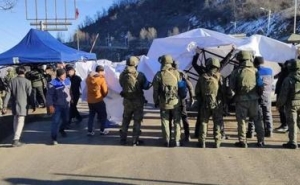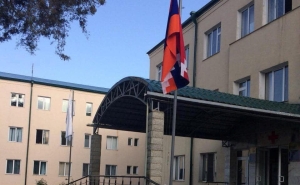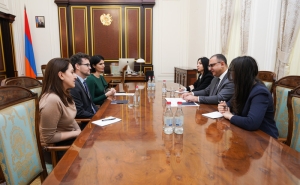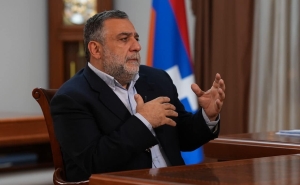Dadivank - A Witness to the Artsakh History

In Artsakh’s Karvachar region, in a beautiful valley where Kharabakh and Mrav mountain chains get closer by a hill, there stands a beautiful monastery, called Dadivank or Khutavank. It is one of the most remarkable medieval architectural complexes of Artsakh Republic.
Etymology of "Dadi" and "Khuta" names are explained in two ways. The first is related to the name of Daddy, who was one of 70 disciples of Apostle St. Thaddeus (one of the 12 apostles of Jesus Christ). In the first century Daddy preached Christianity in Artsakh. However, the people, not yet ready for it, stoned Dadi to death and buried him in the area of present-day Dadivank. When Christianity was adopted as the state religion in the Armenian world in 301, the area became a sanctuary. In 310-311, even Gregory the Illuminator visited the tomb of St. Daddy. In July, 2007, the grave of St. Dadi was discovered under the holy altar of the main church.
Referring to the name "Khuta", we should mention that in Armenian “khut” means small hill, therefore, "Khutavank" literally means a monastery built on a hill.
The Monastery belongs to the Artsakh Diocese of the Armenian Apostolic Church and consists of two bell towers, 2 ancient churches, monk cells, guest house, bookhouse, etc. According to bibliographic sources, the monastery was first mentioned in the 9th century. As evidenced by lithographic records, the monastery was already a vicarial center in the 12th century.
It should be mentioned, that the pearl of the monastic complex is St. Katoghike Astvatsatsin Church built by princess Arzukhatun, the wife of Verin Khachen's prince Vakhtang Vakhtangyan, in 1214. She built the church in memory of her husband and 2 sons (Hasan and Grigor) who died in the war against the Turks.
The buildings of the monastery also prove that many monks have lived and worked in this Episcopal place for centuries. For example, Armenian scholar, writer, public figure, thinker, and priest Mkhitar Gosh lived and worked there for some time.
Dadivank had 200,000 hectares of land, but after Artsakh was annexed to Soviet Azerbaijan in 1920, it lost its estates. In the 1960s, the Azerbaijani authorities established a village in the area of the monastery complex, the residents of which damaged the buildings and frescoes of the Monastery. Dadivank was liberated in 1993 and reopened in 1994.
According to the document signed by 16 members of the Parliamentary Assembly of the Council of Europe (PACE) on October 8, 2001, the demolition of Dadivank in Artsakh is one of the shocking facts of the Azerbaijani policy.
The first phase of Dadivank's restoration began in 1997. Nowadays, the monastery with a new breath stands proudly among Artsakh mountains, ready to welcome its visitors.
-
 17:08
17:08The regular session of the Anti-corruption Policy Council takes place in Jermuk
-
 15:05
15:05The Prime Minister sends congratulatory messages to the supreme leader of Iran and the President of Iran
-
 11:11
11:11Armenia sends earthquake aid to Turkey
-
 10:43
10:43Commemoration of the Pontiff St. Sahak Partev
-
 09:16
09:16Some roads are closed and difficult to pass in Armenia
-
 19:55
19:55Phone conversation of the Foreign Minister of Armenia with the U.S. Assistant Secretary of State for European and Eurasian Affairs
-
 18:30
18:30Prime Minister Pashinyan and President Khachaturyan meet
-
 18:20
18:20Ararat Mirzoyan with Co-Chairman of the OSCE Minsk Group of France Brice Roquefeuil
-
 17:01
17:01Humans could land on Mars within 10 years, Musk predicts
-
 16:45
16:45France, US urge 'immediate' end to Nagorno Karabakh blockade
-
 16:01
16:01Blockaded Nagorno Karabakh launches fundraiser to support quake-hit Syria
-
 15:59
15:59Earthquake death toll in Turkey rises to 18,342
-
 15:43
15:43Ararat Mirzoyan Held a Telephone Conversation with Sergey Lavrov
-
 15:06
15:06French president rules out fighter jet supplies to Ukraine in near future
-
 14:47
14:475 Day Weather Forecast in Armenia
-
 14:44
14:44President Vahagn Khachaturyan wrote a note in the book of condolences opened in the Embassy of Syria in Armenia
-
 14:20
14:20Azerbaijan’s provocations impede establishment of peace and stability – Armenian FM tells Russian Co-Chair of OSCE MG
-
 12:57
12:57France representation to OSCE: Paris calls on Azerbaijan to restore freedom of movement through Lachin corridor
-
 11:40
11:40Command of Kosovo forces highly appreciated preparation of Armenian peacekeepers
-
 10:16
10:16The United States withdrew from sanctions against Syria for six months the provision of assistance after the earthquake
day
week
month
Humidity: %
Wind: km/h









